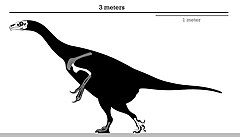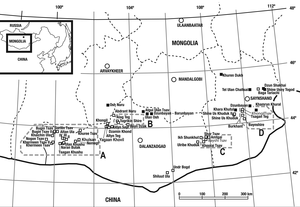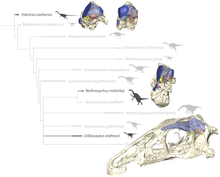Erlikosaurus
| Erlikosaurus | |
|---|---|

| |
| Skeletal diagram of the holotype | |
| Scientific classification | |
| Domain: | Eukaryota |
| Kingdom: | Animalia |
| Phylum: | Chordata |
| Clade: | Dinosauria |
| Clade: | Saurischia |
| Clade: | Theropoda |
| Superfamily: | † Therizinosauroidea
|
| Family: | †Therizinosauridae |
| Genus: | †Erlikosaurus Barsbold & Perle, 1980 |
| Type species | |
| †Erlikosaurus andrewsi Barsbold & Perle, 1980
| |
| Synonyms | |
| |
Erlikosaurus (meaning "
In contrast to most therizinosaurids, Erlikosaurus was a small member reaching nearly 3.4 m (11 ft) in length and 150 to 250 kg (330 to 550 lb) in mass. It had a well-developed beak at the snout tip and toothed jaws that were used for its
Erlikosaurus is classified as a therizinosaur within the
Discovery and naming

The

Confusingly, in 1981 Perle again named and described the species as if it were new, but this time in more detail and spelling the generic name as a Latinised "Erlicosaurus".[2] It is today widely accepted by most authors that the original name, Erlikosaurus, is valid. At the time of its discovery it was the only known therizinosaur (then called segnosaurs[6]) for which a complete skull had been discovered, this helped shed light on a puzzling and poorly known group of dinosaurs. It still represents the most completely known therizinosaurian skull.[4][5]
In
Description

As the genus is only known from very fragmentary material, it has been problematic to determine the size of Erlikosaurus, especially as most of the vertebral column of the holotype is missing. The skull of the holotype specimen length is approximately 25 cm (250 mm) long, indicating a very small individual. Overall, Erlikosaurus was a small-sized therizinosaurid, estimated to have reach about 3.4 m (11 ft) with a more lightly built than the ponderous Segnosaurus.[12] In 2012 Stephan Lautenschlager and colleagues used theropod-specific equations to estimate the body mass of Erlikosaurus and other therizinosaurs. However, since the femur is unknown, they used bivariate regression analyses on log-transformed data for Erlikosaurus. The results ended up on a femoral length of 44.33 cm (443.3 mm) and a weight of 173.7 kg (383 lb). Given the uncertainties of these estimates, they established an overall mass range between 150 and 250 kg (330 and 550 lb).[5] Alternative estimations have suggested a maximum length of 6 m (20 ft) long,[9] and a more conservative length of 4.5 metres and a weight of 500 kg (1,100 lb).[13] Though Erlikosaurus largely lacks body remains, as a therizinosaurid it would have had a strong arm build with large claws, a broad and bulky torso, and an opisthopubic (directed backwards) pelvis.[14] It is known that therizinosaurs were feathered animals based on the preserved feather impressions in specimens of Beipiaosaurus and Jianchangosaurus, so it is likely that Erlikosaurus was feathered as well.[15][16]
Skull
The snout is moderately elongated, with a
The well preserved

In Erlikosaurus, the presence of a keratinous beak on the maxilla and premaxilla can be inferred by the presence of numerous neurovascular foramina on the rostral and lateral surfaces in the skull, furthermore, it bears all the mentioned features above, however, it is unclear the extension of the beak.[17] The preserved rhamphotheca in specimens of Gallimimus and Ornithomimus evidences that the keratin sheath covered the premaxilla and overlapped it on the lower side by a few millimeters.[18] In some extant birds, the rhamphotheca is typically restricted to the premaxilla and maxilla, although in some cases it partially covers the nasal process in some birds.[20] Apparently, in Erlikosaurus the rhamphotheca covered the nasal process of the premaxilla.[17]
Postcranial skeleton

Body remains of Erlikosaurus are very sparse compared to the cranial elements, consisting of a
The preserved right
The left
Classification

Erlikosaurus was by Perle assigned to the
The relationships of therizinosaurs were quite complicated when the first members were discovered. As an example, the first known therizinosaur taxon,
Consequently, therizinosaurs are now classified as theropods, within the

| Therizinosauridae |
| ||||||||||||||||||||||||||||||||||||
Paleobiology
Senses

Erlikosaurus is poorly known from postcranial material, but the holotype skull became the focus of study in
In
Feeding and bite force

In

The well preserved jaws also allowed a study by the University of Bristol to determine how its feeding style and dietary preferences were linked to how wide they could open the mouth. In the study, performed by Lautenshlager and colleagues in 2015, it was revealed that Erlikosaurus could open its mouth to a 43 degree angle at maximum. Also included in the study for comparison were the carnivorous theropods Allosaurus and Tyrannosaurus. From the comparisons, it was indicated that carnivorous dinosaurs had wider jaw gapes than herbivores, much as modern carnivorous animals do today.[30]
In 2016, using Finite Element Analysis (FEA) and a Multibody Dynamics Analysis (MDA), the bite forces of Erlikosaurus, Plateosaurus and Stegosaurus were tested in order to estimate dietary habits. The resulting bite force for Erlikosaurus was between 50 and 121 N, with a skull characterised by high susceptibility to stress and deformation that indicates a feeding behaviour specialized in the active use of the beak. The results further support that Erlikosaurus relied on postcranial musculature to compensate the low bite force and to relieve stresses on cranial structure.[31]
Paleoenvironment
The holotype of Erlikosaurus was unearthed from the Bayshin Tsav locality at the upper boundary of the
Coexistence with Segnosaurus
Erlikosaurus lived alongside a larger species of therizinosaurid in the Bayan Shireh Formation,

In a 2017 study of niche partitioning in therizinosaurs through digital simulations, Lautenschlager found the straighter and more elongated dentaries of primitive therizinosaurs had the highest magnitudes of stress and strain during extrinsic feeding scenarios. In contrast, Erlikosaurus and Segnosaurus were aided by the down-turned tip of the lower jaws and symphyseal (bone union) regions, and probably also by stress and strain-mitigating beaks. The results also showed a difference in bite forces between Segnosaurus and Erlikosaurus, indicating the former would have been able to feed on tougher vegetation, while the overall robustness of the latter suggests greater flexibility in its manner of feeding. Lautenschlager pointed out the two taxa were adapted to different modes food acquisition, and that the difference in size and heights between the two therizinosaurids further separated their niches. While Segnosaurus was adapted to use its specialized dentition to procure or process food, Erlikosaurus mostly relied on its beak and neck musculature for cropping while foraging.[45]
In addition to these cranial differences, in 2019 Button and Zanno note that herbivorous dinosaurs followed two main distinct modes of feeding. One of these was processing food in the gut which is characterized by gracile skulls and relatively low bite forces, and the second was oral food processing, characterized by features associated with extensive processing such as the lower jaws or dentition. Segnosaurus was found to be in the former mode, whereas Erlikosaurus was more likely to fall in the second group, further supporting that these two therizinosaurids were separated by a well-defined niche differentiation.[46]
See also
References
- ^ a b c d e f g Barsbold, R.; Perle, A. (1980). "Segnosauria, a new suborder of carnivorous dinosaurs" (PDF). Acta Palaeontologica Polonica. 25 (2): 190–192.
- ^ a b c d e f Perle, A. (1981). "Novyy segnozavrid iz verkhnego mela Mongolii" [New Segnosauridae from the Upper Cretaceous of Mongolia]. Transactions of the Joint Soviet-Mongolian Paleontological Expedition (in Russian). 15: 50–59. Translated paper
- ^ hdl:2246/3712.
- ^ S2CID 53405097.
- ^ PMID 23284972.
- ^ Perle, A. (1979). "Segnosauridae — novoe semejstvo teropod iz pozdnego mela Mongolii" [Segnosauridae — a new family of theropods from the Late Cretaceous of Mongolia]. Transactions of the Joint Soviet-Mongolian Paleontological Expedition (in Russian). 8: 45–55. Translated paper
- ^ a b Barsbold, R. (1983). "Хищные динозавры мела Монголии" [Carnivorous dinosaurs from the Cretaceous of Mongolia] (PDF). Transactions of the Joint Soviet-Mongolian Paleontological Expedition (in Russian). 19: 107. Translated paper
- ISBN 978-0-6911-3720-9.
- ^ ISBN 0-7853-0443-6.
- ^ PMID 30995236.
- ^ PMID 31333906.
- ^ ISBN 9780691167664.
- PMID 26061728.
- ^ S2CID 204993327.
- PMID 23734177.
- ^ .
- ^ S2CID 4313779.
- .
- ^ Knutsen, E. M. (2007). Beak morphology in extant birds with implications on beak morphology in ornithomimids (PDF). University of Oslo. p. 44.
- ^ Ostrom, J. H. (1969). "Osteology of Deinonychus antirrhopus, an Unusual Theropod from the Lower Cretaceous of Montana" (PDF). Peabody Museum of Natural History Bulletin. 30: 1–165. Archived from the original (PDF) on 2020-05-04. Retrieved 2020-01-26.
- ^ Maleev, E. A. (1954). "Noviy cherepachoobrazhniy yashcher v Mongolii" [New turtle−like reptile in Mongolia]. Priroda (3): 106–108. Translated paper
- ^ Rozhdestvensky, A. K. (1970). "On the gigantic claws of mysterious Mesozoic reptiles". Paleontologicheskii Zhurnal (in Russian) (1): 131–141.
- JSTOR 4523011.
- doi:10.1139/e93-183.
- ^ Dong, Z. (1979). Dinosaurs from the Cretaceous of South China (PDF) (in Chinese). Mesozoic and Cenozoic Red Beds of South China, Science Press. pp. 342–350.
- PMID 31185870.
- PMID 23061752.
- PMID 24297877.
- PMID 26716007.
- PMID 27199098.
- ^ Tsybin, Y. I.; Kurzanov, S. M. (1979). "New data on Upper Cretaceous localities of vertebrates of Baishin-Tsav region". Transactions of the Joint Soviet-Mongolian Paleontological Expedition. 8: 108–112.
- ^ .
- .
- JSTOR 3515188.
- ^ S2CID 86032547.
- OCLC 69865262.
- hdl:2115/14579.
- S2CID 212423361.
- ^ Sereno, P. C. (2000). "The fossil record, systematics and evolution of pachycephalosaurs and ceratopsians from Asia" (PDF). The Age of Dinosaurs in Russia and Mongolia. Cambridge University Press. pp. 489–491.
- ^ Watabe, M.; Tsogtbaatar, K.; Sullivan, R. M. (2011). "A new pachycephalosaurid from the Baynshire Formation (Cenomanian-late Santonian), Gobi Desert, Mongolia" (PDF). Fossil Record 3. New Mexico Museum of Natural History and Science, Bulletin. 53: 489–497.
- S2CID 86304259.
- PMID 25714338.
- PMID 27069815.
- S2CID 90965431.
- S2CID 208652510.


